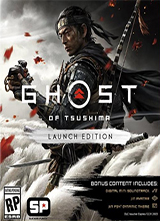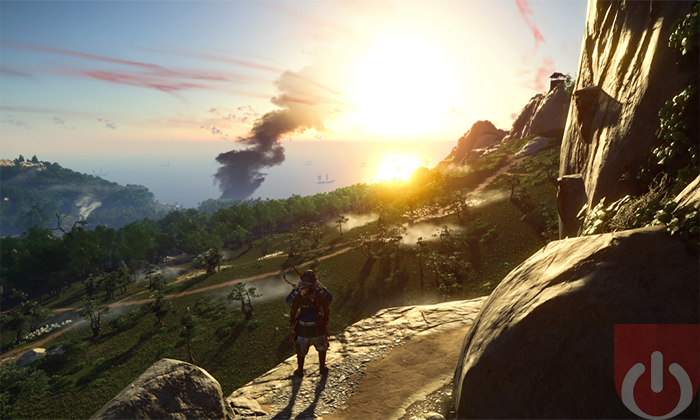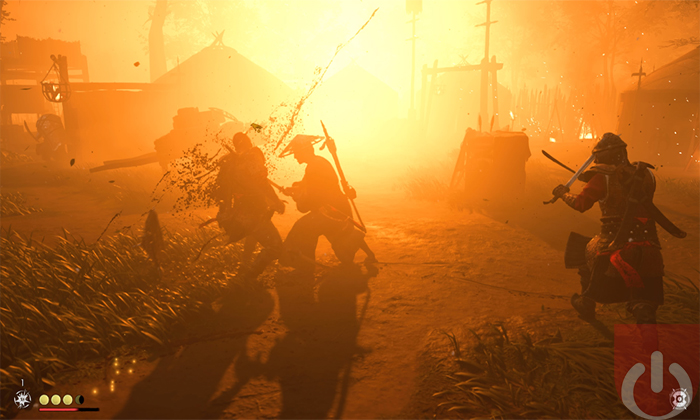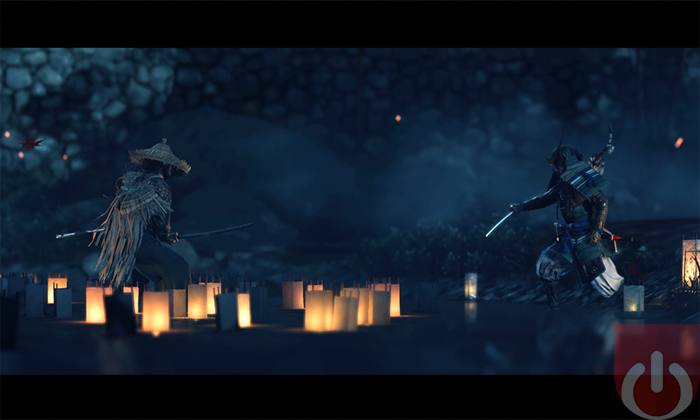Ghost of Tsushima
Ghost of Tsushima offers a “Kurosawa Mode.” That selection turns visuals black & white, a grain filter scatters about the frame, and simulated emulsion scratches mar the digital perfectionism. It’s a game about samurai – suitable, then, to hearken back to director Akira Kurosawa and his faultless filmography. Yet, also a soullessly marketable correlation.
No question Ghost of Tsushima is often stunning. Its use of sunsets, fog, and forests encapsulate a near virgin Japan circa 1200-1300. On occasion, it’s unequivocally Kurosawa-esque, sometimes in direct homage, other times in subtle methods. But it’s all created, not found. Certainly, Ghost of Tsushima was difficult to create; thousands of man hours went into this technical luxury. The effort cannot be denied.
This is not a film camera though, where a cinematographer’s eye finds lushness in the natural world. In Ghost of Tsushima, seasons change when wandering on horseback between villages, defying logic because lengthy video games demand variety rather than a constant. Film historians would wonder aloud why Kurosawa left such a blatant continuity error in his work; Ghost of Tsushima allows it to happen even with its control.
Usually, statements connecting famous filmmakers to video games come from marketing divisions. Not so much here. Ghost of Tsushima points a direct line to Kurosawa, making this unavoidable. It’s absurd, really.
Not that video games can’t produce something emotive, historically thrilling, or character-rich, rather their identity adheres to another industry’s credibility; video games look foolish in doing so. Kurosawa never directed a story about a lone samurai rummaging through peasant homes, stealing scrap iron. In the first hour, Ghost of Tsushima asks protagonist Jin to drop his life long code and beliefs to slaughter invading Mongol tribes without warning. He does, because gameplay demands it, and suddenly, Jin is more ninja than samurai.
Undoubtedly Ghost of Tsushima involves accurate armor styles, recounts historical fables, and pays heed to proper sword fighting styles. Its world looks both lived in and untouched, its people suffering (but villains are only insufferable, cardboard-thin brutes). The story winds through generational dissent, with the young rejecting tradition, the elders taken aback by their defiance. Resistance and rebellion against Mongols succumb to the invader’s divide and conquer tactics, in which heroes bicker over samurai customs. When banded together, the Mongols lose. It’s an ancient moral from which humanity never learns despite frequency in history, fiction, and current real world events.
For some 25 hours Jin roams this land, freeing its people from cages (more modern relevance), and slashing Mongol tribes. There’s an element of cool – too much so – that celebrates elaborate theatrical executions, partly selling Jin’s defiance, but ludicrous since Jin started this journey never having killed from above. In acquiring a grappling hook, an invention without a name in this period, Jin leaps and clings to trees as if already beyond practice, or maybe just because Nathan Drake did so in a different Sony-made game franchise.
Genre convention weakens Ghost of Tsushima, shattering the Kurosawa link. Ghost of Tsushima doesn’t influence anything; it’s a hodgepodge of open world ideals, strung together by a samurai theme because pirates, adventurers, gun runners, and futurist heroes were already taken. It is admittedly enjoyable to traverse Tsushima’s landscapes, encountering roving Mongol bands, and helping those in need. The strict, well-scripted fighting elevates the arcade beat-em-up’s depth, yet where those games ran for an hour, Ghost of Tsushima breaches 25 or more. Imagine: Akira Kurosawa’s Double Dragon. Or don’t, because it’s too depressing to contemplate.
Gameplay:
5
A safe but catchy brawler and an open world borrowed from endless other genre entries.
Graphics:
8
Often stunning in its vistas, the occasional drop in lighting fidelity saps some of the energy, yet fighting against sun-backed fog is scintillating.
Sound:
8
Well voiced performances deliver the needed drama. Much appreciated is a Japanese subtitled option, but good luck following any conversation in the midst of combat.
Replay Value:
3
By the time the story is over, the repetitive fighting loses its luster, and the thought of heading back to uncover the map sounds more grueling than enjoyable.
Final Score:
6



